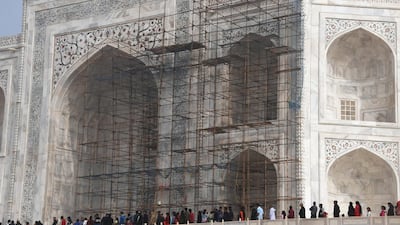It is India's most renowned monument, a visual wonder steeped in romance and visited by millions every year. But the task of cleaning the Taj Mahal has left national heritage officials with a problem: how to scale and scrub the building's delicate dome?
The man in charge does not yet have an answer.
"There are a lot of calculations we need to make," said Bhuvan Vikrama, the Taj Mahal's superintendent, in Agra. "We're having to think very hard about it."
Mr Vikrama works for the Archaeological Survey of India, which is responsible for the cleaning.
For centuries after the Taj Mahal's completion, in 1653, it required only a wash of rain to sweep away any dirt that may have coated the marble. But in the industrial age, the facades began to be coated in more persistent grime.
Workers started the current cleaning in the summer of 2015, in an attempt to restore its exteriors to their familiar, spotless-white brilliance.
But airborne pollution from factories in and around Agra left residues on the surface of the monument. Right next to the Taj Mahal, the Yamuna has become one of India’s filthiest rivers; the water pollution has, in turn, led to an explosion of a midge-like insect called Goeldichironomus.
______________________
BJP officials attempt to wipe Taj Mahal off the tourist trail
The Taj Mahal has been caught in a rising tide of narrow nationalism
______________________
The insects frequently rise in clouds from the Yamuna and settle on the back wall of the Taj Mahal, the wall closest to the river. Here they excrete a substance full of chlorophyll, which leaves green stains upon the shining marble.
The monument, built as a mausoleum by the Mughal emperor Shah Jahan for his beloved wife Mumtaz Mahal, attracts seven to eight million visitors every year, according to government statistics.
Roughly 800,000 come from overseas just to see the Taj Mahal, its profile so seemingly perfect that the poet Rabindranath Tagore described it as "a teardrop on the cheek of time".
The cleaning project has been conducted despite visitors tramping through the site. Workers have had to be careful not to use chemicals that risk pitting or dissolving the marble. Instead, as if the Taj Mahal were a customer at their beauty parlour, Mr Vikrama administered it a mud pack.
"We use Fuller’s earth," a clay mineral, "in a paste and apply it on the marble," he said. "When it dries, it tends to naturally extract the impurities from the surface. Then it's taken off, and the surface is washed down with water."
The process is slow. Fuller's earth needs time to dry, and workers can work on only a small patch at a time. Between 30 and 40 workers at a time have been treating small sections of the walls and the minarets with Fuller’s earth over the last two-and-a-half years, using scaffolding to access the upper reaches.
But the same scaffolding cannot be used on the onion-shaped dome, which spans 58 feet across and 115 feet in height. The dome weighs more than 12,000 tonnes, but it is still a delicate structure, and vulnerable if any significant load is added upon it.
"The usual metal scaffolding would be too heavy," Mr Vikrama said.
"We’re calculating the load of the scaffolding. Maybe if there's a lighter version of modern scaffolding, that's a possibility."
An alternative might involve bamboo. In the 1940s, when minor repairs were carried out upon the dome, a bamboo scaffold was erected.
Once work on the dome begins, it will require an estimated nine to 12 months to complete the cleaning. "We have to be careful, but we'll eventually get there.”," Mr Vikrama added.
Although the stains aren't damaging, they are hard to miss. When Prakash Srikumar travelled from Chennai to Agra with his family in December, he noticed the splodges of green upon the wall.
"It definitely ruins the beauty of the Taj Mahal," Mr Srikumar told The National.
"From afar, when you're walking towards it, it looks white and pristine. But you get up close and you see all this grime and these green spots as well."
The scaffolding and disruption are not the only worry for the building's caretakers.
Many believe the number of visitors is reaching unsustainable levels. In December, not long after Mr Srikumar visited, a temporary ban on entering the main crypt of the Taj Mahal, which holds replicas of the graves of Shah Jahan and Mumtaz Mahal, was invoked.
From April 1, when the crypt reopens, tourists will have to pay an additional 200 rupees to enter it, in addition to the 50 rupee admission ticket for the Taj Mahal itself.

